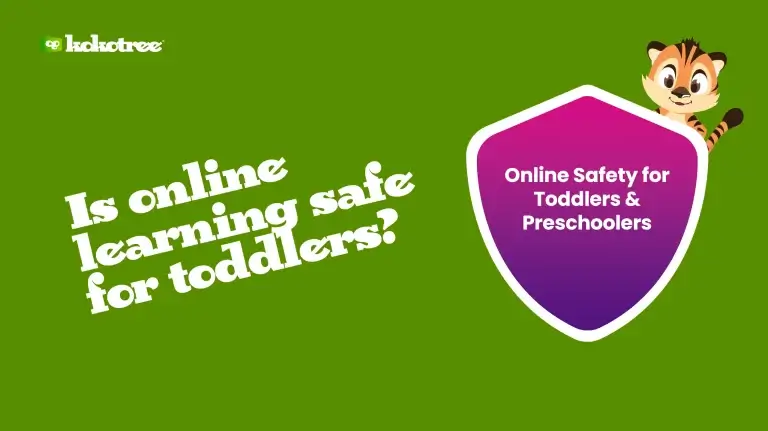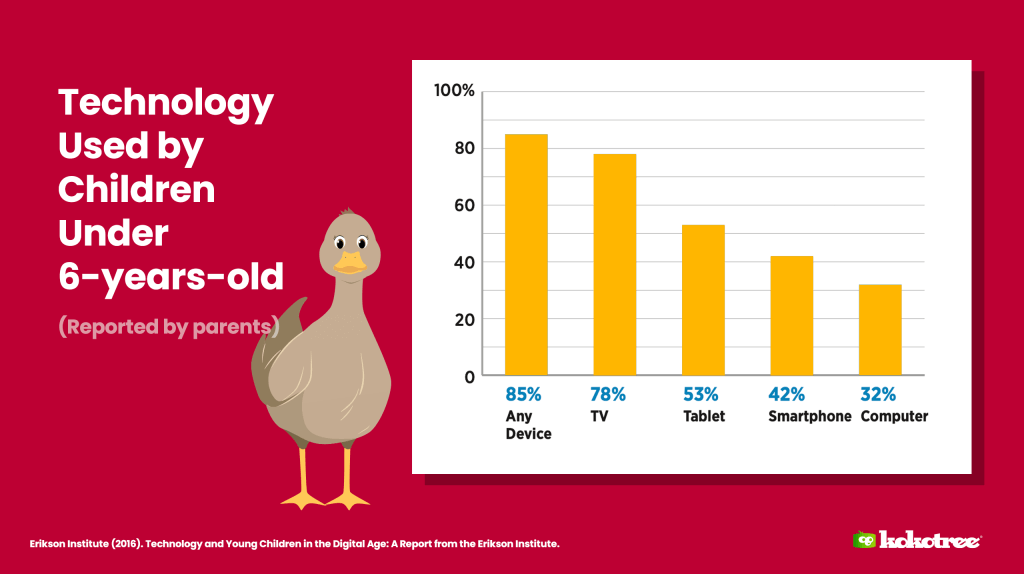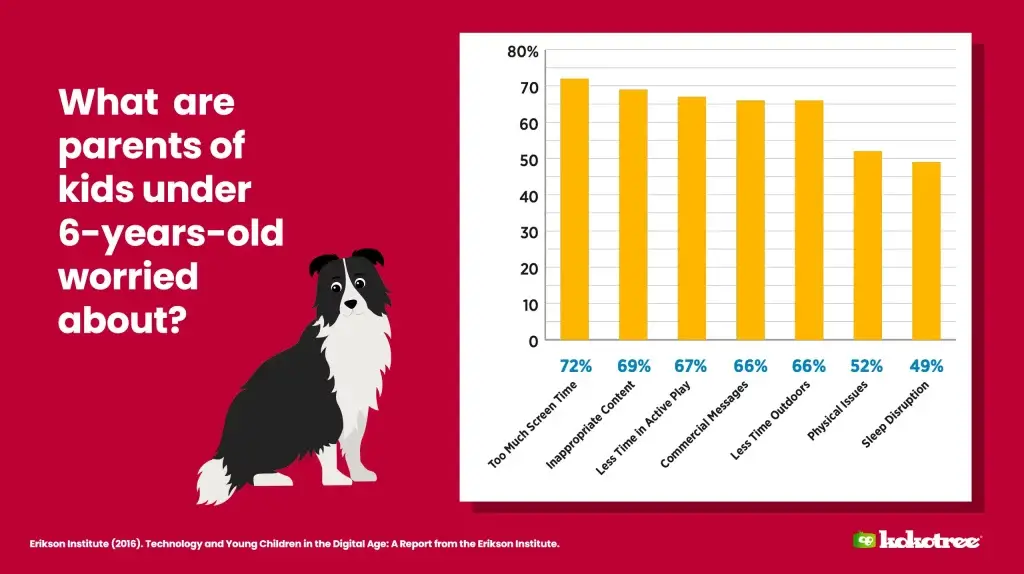

As a parent, your top priority is ensuring your child receives the best education possible. This often means looking for safe and effective online learning programs. However, knowing which is suitable for your child can be challenging because there are many options.
In a survey of 1000 parents in the US, 85 percent allow their children under six years of age to use at least one electronic device at home (Erikson Institute, 2016).


This is not a big surprise. Let’s look at this. Most parents are concerned about:
As a result, parents are looking for ways to minimize these risks by finding online learning that is safe and effective.
A recent study found that 38 percent of parents do not feel confident in their ability to monitor what their children are doing online (Common Sense Media, 2016).
Yet, they open YouTube, Netflix, Disney+, or some other dangerous streaming service. Most parents hand their child the phone, and let them watch an endless rabbit-hole stream of videos.
Recommended: 9 Dangers of YouTube, Netflix, Disney+ for Preschoolers and Toddlers
YouTube is a free-for-all where anyone can upload content for kids without checks and balances. Your child could be watching videos with inappropriate content, violence, or explicit language without you knowing.
Many reports of children watching disturbing content on YouTube are reported in the media. A UK mother said her five-year-old son found a video of a man being shot in the head on YouTube Kids. In 2018, a father in the US reported that his six-year-old daughter had found a cartoon on YouTube Kids that featured characters being decapitated and dismembered.
While YouTube claims they are working on solving these issues, there is no guarantee that the content on their kid’s app is age-appropriate. The app relies on algorithms to surface videos for kids, but these algorithms are not perfect.
Many commercials are inserted into the beginning or middle of videos and cannot be skipped. These ads are often for products that are not appropriate for children, such as alcohol, prescription drugs, gambling, and violence.
There are several potentially harmful effects of young children viewing inappropriate commercials on YouTube. First, they may be exposed to content that is not appropriate for their age group. Second, they may be unable to understand the context of the advertisement and think that the advertised product is something they should want or need. Finally, they may be more likely to imitate the behavior being shown in the advertisement (e.g., if the ad is for alcohol, they may be more likely to try drinking alcohol).
As a parent, you want to know that your children are getting the most out of online learning academically and physically. But you may not have the time to read up on the latest research in early childhood education. So we’ve done it for you.
With about 1.2 billion children out of the classroom worldwide due to the COVID-19 pandemic, many educational technology companies have given students and teachers free access to their platforms or are working directly with school districts to offer a wide range of online learning options (Li, C., Lalani, F., 2020).
But many schools continue to struggle to provide online learning that works for their students. And for the parents and children working and learning at home, some are thriving, and others are not.
A study by Aurora Institute found that for the new “at-home” online learning environment to work for parents and children, reliable internet service, support from parents or siblings, a suitable electronic device, and quiet and private space available in the home led to the best results (Wenmoth, D., Jones, M., DiMartino, J., 2021).
During lockdowns, some students lost motivation to learn because they couldn’t interact with their peers. Yet, some students had positive experiences in their new online learning environment. These students loved being able to learn at their own pace and enjoyed getting help from family members and using different spaces at home to learn. They tended to have online teachers that gave them more individualized support.
Today, online learning is an essential component of a child’s education. The quality of online educational content varies widely. Without recommendations made by a child’s teacher or school district, it’s difficult to determine if a single online video or a paid subscription to an online educational platform will deliver an educational benefit to your child.
Universal Design for Learning or UDL (CAST, 2018) is one scientifically founded set of guidelines known to maximize learning. When using UDL principles in online education, a child is more likely to be engaged, motivated, and challenged. Children differ in what motivates and engages them and how they prefer to express themselves.
Below are three key questions parents can ask to decide if their children’s online learning is likely effective. See the CAST website for more details.
Research has demonstrated that social and emotional skills learned in early childhood lead to long-term positive outcomes, including educational achievement and mental health (Djamnezhad, D., Koltcheva, K., Dizdarevic, A. et al., 2021).
Through SEL, children learn to understand and manage their emotions and how to have positive relationships with others. A safe and supportive online learning environment can support a child’s development of these skills. But, online or offline, it’s recommended that SEL for preschoolers incorporate both play and activities in which children work together with their peers.
SEL will be most effective if children are directly taught the skills, given practice using the skills during learning activities, and then apply the skills to other situations in their daily lives (McClelland, M., Tominey, S., Schmitt, S., et al., 2017).
A recent study demonstrated that preschoolers grew in their understanding of emotions and applied strategies for regulating emotions after watching the Daniel Tiger’s Neighborhood television program and using the related app (Rasmussen, E., Strouse, G., Colwell, M., et al., 2018).
Another characteristic of effective online learning is agency (Wenmoth, D., Jones, M., DiMartino, J., 2021). Renaissance, a global leader in pre-K-12 education technology, provides a great definition of student agency.
Student agency refers to learning through activities that are meaningful and relevant to learners, driven by their interests, and often self-initiated with appropriate guidance from teachers.
To put it simply, student agency gives students a voice and, often, choice in how they learn. (Renaissance, 2022)
A healthy learning environment supports children in taking more responsibility for themselves and their learning over time and builds responsibility toward others and the environment.
When parents participate in learning activities with their children, they can support them in taking risks and making mistakes.
Ideally, an online learning environment, like a classroom, allows children to make choices while working with other children and teaches children how to handle conflict.
Parents must understand young children’s risks of unmonitored screen time and protect them from harm.
The American Academy of Child & Adolescent Psychiatry (AACAP) warns that unregulated screen time may leave children vulnerable to acts of violence, unhealthy risk-taking behavior, substance abuse, bullying, and manipulative advertising, among other threats (AACAP, 2020).
Research indicates that large amounts of screen time and the viewing of low-quality online content by children are related to behavior and attention problems, sleep problems, obesity, and poorer development of language and social skills (Mayo Clinic, 2022).
Preschoolers having only two hours of screen time per day have worse attention problems than their peers who have fewer (Tamana, S., Ezeugwu, V., Chikuma, J., et al., 2019).
The American Optometric Association (AOA) recommends screen time for preschoolers to be no more than one hour per day. It warns that too much screen time and a sedentary lifestyle may lead to poorer communication skills, inadequate fine motor skills (needed for writing), a reduced vocabulary, increased risk for mental health disorders, and thinning of the cortex in the brain (AOA, 2019).
It’s not just the amount of time spent gazing at screens that impact a child’s brain and development.
When choosing online educational videos for children, for example, there are other essential and specific things to look for. Videos for young children must be slow-paced, calm, and not involve a large amount of movement, fast movements, or too many distracting visuals and sounds (Madrigal, 2018).
While children might enjoy videos with these elements and appear to be engaged, the truth is that children cannot focus on what they are learning with these distractions. Unfortunately, children who watch these types of videos may find more effective educational videos boring.
Some research has shown that watching educational television by children ages 3 to 5 years has a positive effect on reading recognition and short-term memory but does not help children develop more complex skills like reading comprehension and math skills (Zimmerman, F., Christakis, D. 2005).
While reducing a child’s screen time is essential, some researchers point out that parents should focus more on the quality of online learning and the time spent participating in online education with their children rather than the total screen time (Courage, M., 2017).
Here are some general guidelines to help parents prevent screen time’s negative impacts and make the most of screen time for children ages 3-5.
Kokotree is an early childhood development platform offering a holistic, or “whole child,” educational experience.
Whole child education aims to create a positive learning environment that supports and connects children’s development across multiple dimensions: academics, physical health, cognitive development, and social and emotional development (Darling-Hammond, L., Cook-Harvey, C., 2018).
In holistic education, children engage in personalized learning in a safe environment, learn how to live a healthy lifestyle, and are involved in their community (Rosales, 2019).
Whole child education believes that success in life comes from a combination of meaningful learning at school and in everyday life, a positive school environment, and healthy relationships (Learning Policy Institute, 2022).
By design, Kokotree provides a safe and personalized online learning experience to instill a lifelong love of learning.
Kokotree knows that parents are wary of allowing their children to use streaming services and desire a trustworthy, safe, and high-quality educational option. Even reputable education companies (Khan Academy Kids) with research-based learning activities proven effective for young children may rely on YouTube to host some of their interactive learning experiences.
Designed by experts in education, Kokotree tightly controls the video content available to a child, the pacing of the videos and learning sequences, and the options for navigating from one video or learning activity to the next, allowing children to get the most out of online learning.
In addition, Kokotree has created research-based animated video learning that involves children with social and emotional learning, learning with family members, and interacting with the community and the natural world.
Kokotree’s learning activities and videos are age-appropriate, engaging, self-paced, and based on education frameworks from around the world with the goal that all children can access quality educational content that reinforces what they are learning in school.
Kokotree understands that parents may not be able to monitor their child’s online learning as much as they’d like. Kokotree assists parents by providing notifications about what their children are viewing and learning, as well as reports on their child’s progress, performance, and strengths and weaknesses.
Kokotree also incorporates parent participation in their learning programs so that they learn beside their child online and further elaborate on the learning offline at home and in the world.
_____________________
American Optometric Association (2019) New WHO guidance: Very limited daily screen time recommended for children under 5. Retrieved from https://www.aoa.org/news/clinical-eye-care/public-health/screen-time-for-children-under-5?sso=y [Accessed June 7, 2022]
American Academy of Child & Adolescent Psychiatry (2022) Screen Time and Children. Retrieved from https://www.aacap.org/AACAP/Families_and_Youth/Facts_for_Families/FFF-Guide/Children-And-Watching-TV-054.aspx [Accessed June 7, 2022]
Courage, M. (2017) Chapter 1 – Screen Media and the Youngest Viewers: Implications for Attention and Learning. 3-28. https://doi.org/10.1016/B978-0-12-809481-5.00001-8
CAST (2018). The UDL Guidelines. Retrieved from https://udlguidelines.cast.org/ [Accessed June 7, 2022]
Darling-Hammond, L., Cook-Harvey, C. (2018) Educating the Whole Child: Improving School Climate to Support Student Success. Retrieved from https://learningpolicyinstitute.org/product/educating-whole-child-report [Accessed June 9, 2022]
Djamnezhad, D., Koltcheva, K., Dizdarevic, A., Mujezinovic, A., Peixoto, C. et al. (2021) Social and Emotional Learning in Preschool Settings: A Systematic Map of Systematic Reviews. Front. Educ. https://doi.org/10.3389/feduc.2021.691670
Erikson Institute (2016). Technology and Young Children in the Digital Age: A Report from the Erikson Institute.
Learning Policy Institute. Whole Child Education. Retrieved from https://learningpolicyinstitute.org/issue/whole-child-education [Accessed on June 9, 2022]
Li, C., Lalani, F. (2020) The COVID-19 pandemic has changed education forever. This is how. World Economic Forum. Retrieved from https://www.weforum.org/agenda/2020/04/coronavirus-education-global-covid19-online-digital-learning/ [Accessed June 7, 2022]
Madrigal, A. (2018) Raised by YouTube. Retrieved from https://www.theatlantic.com/magazine/archive/2018/11/raised-by-youtube/570838/ [Accessed June 7, 2022]
Mayo Clinic (2022) Screen time and children: How to guide your child. Retrieved from https://www.mayoclinic.org/healthy-lifestyle/childrens-health/in-depth/screen-time/art-20047952#:~:text=Developing%20screen%20time%20rules&text=If%20you%20introduce%20digital%20media,doesn’t%20work%20as%20well [Accessed June 7, 2022]
McClelland, M., Tominey, S., Schmitt, S., Duncan, R. (2017) SEL Interventions in Early Childhood. Future of Children, 27 (1), 33-47.
Rasmussen, E., Strouse, G., Colwell, M., Russo Johnson, C., Holiday, S. Brady, K. (2018) Promoting Preschoolers’ Emotional Competence Through Prosocial TV and Mobile App Use. 22 (1) 1-22. https://doi.org/10.1080/15213269.2018.1476890
Rosales, J. (2019) Bridging the Gap: Serving the Whole Child Involves Every Educator. NEA News. Retrieved from https://www.nea.org/advocating-for-change/new-from-nea/bridging-gap-serving-whole-child-involves-every-educator [Accessed June 7, 2022]
Tamana, S., Ezeugwu, V., Chikuma, J., Lefebvre, D., Azad, M, et al. (2019) Screen-time is associated with inattention problems in preschoolers: Results from the CHILD birth cohort study. PLoS ONE 14(4): e0213995. https://doi.org/10.1371/journal.pone.0213995
Wenmoth, D., Jones, M., DiMartino, J. (2021). Agency by Design: Making Learning Engaging. Arlington, VA: Aurora Institute.
Renaissance. “What Is Student Agency?” Renaissance, 29 Feb. 2022, www.renaissance.com/edword/student-agency.
Zimmerman, F., Christakis, D. (2005) Children’s Television Viewing and Cognitive Outcomes: A Longitudinal Analysis of National Data. Arch Pediatr Adolesc Med. 159(7):619–625. doi:10.1001/archpedi.159.7.619




